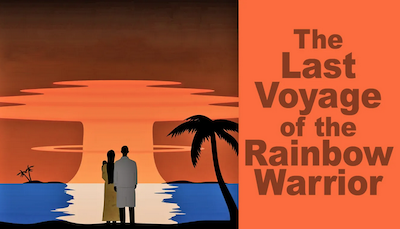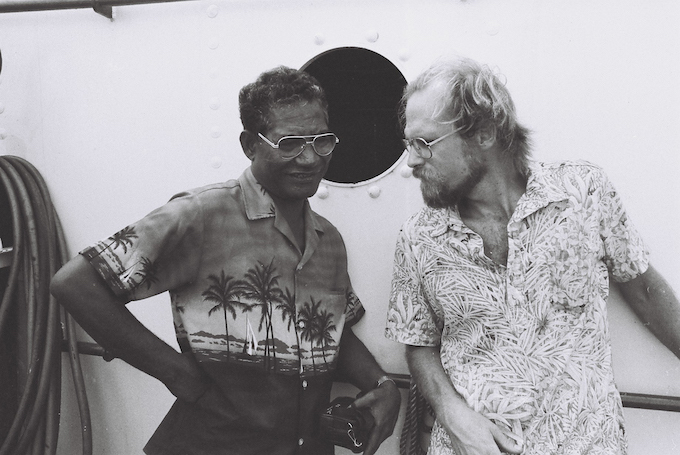How Jeton Anjain planned the Rongelap evacuation – new RNZ Rainbow Warrior podcast series
REVIEW: By Giff Johnson in Majuro
As a prelude to the 40th anniversary of the evacuation of Rongelap Islanders to Mejatto Island in Kwajalein in 1985, Radio New Zealand and ABC Radio Australia have produced a six-part podcast series that details the Rongelap story — in the context of The Last Voyage of the Rainbow Warrior, the name of the series.
As a prelude to the 40th anniversary of the evacuation of Rongelap Islanders to Mejatto Island in Kwajalein in 1985, Radio New Zealand and ABC Radio Australia have produced a six-part podcast series that details the Rongelap story — in the context of The Last Voyage of the Rainbow Warrior, the name of the series.
It is narrated by journalist James Nokise, and includes story telling from Rongelap Islanders as well as those who know about what became the last voyage of Greenpeace’s flagship.
It features a good deal of narrative around the late Rongelap Nitijela Member Jeton Anjain, the architect of the evacuation in 1985. For those who know the story of the 1954 Bravo hydrogen bomb test at Bikini, some of the narrative will be repetitive.
- READ MORE: New podcast: The Last Voyage of the Rainbow Warrior – ABC/RNZ
- Podcast details Rongelap evacuation – Marshall Islands Journal
- Crimes NZ: David Robie on the bombing of the Rainbow Warrior – RNZ

The Last Voyage of the Rainbow Warrior podcast series logo. Image: ABC/RNZ
But the podcast offers some insight that may well be unknown to many. For example, the podcast lays to rest the unfounded US government criticism at the time that Greenpeace engineered the evacuation, manipulating unsuspecting islanders to leave Rongelap.
Through commentary of those in the room when the idea was hatched, this was Jeton’s vision and plan — the Rainbow Warrior was a vehicle that could assist in making it happen.
The narrator describes Jeton’s ongoing disbelief over repeated US government assurances of Rongelap’s safety. Indeed, though not a focus of the RNZ/ABC podcast, it was Rongelap’s self-evacuation that forced the US Congress to fund independent radiological studies of Rongelap Atoll that showed — surprise, surprise — that living on the atoll posed health risks and led to the US Congress establishing a $45 million Rongelap Resettlement Trust Fund.
Questions about the safety of the entirety of Rongelap Atoll linger today, bolstered by non-US government studies that have, over the past several years, pointed out a range of ongoing radiation contamination concerns.
The RNZ/ABC podcast dives into the 1954 Bravo hydrogen bomb test fallout exposure on Rongelap, their subsequent evacuation to Kwajalein, and later to Ejit Island for three years. It details their US-sponsored return in 1957 to Rongelap, one of the most radioactive locations in the world — by US government scientists’ own admission.
The narrative, that includes multiple interviews with people in the Marshall Islands, takes the listener through the experience Rongelap people have had since Bravo, including health problems and life in exile. It narrates possibly the first detailed piece of history about Jeton Anjain, the Rongelap leader who died of cancer in 1993, eight years after Rongelap people left their home atoll.
The podcast takes the listener into a room in Seattle, Washington, in 1984, where Greenpeace International leader Steve Sawyer met for the first time with Jeton and heard his plea for help to relocate Rongelap people using the Rainbow Warrior. The actual move from Rongelap to Mejatto in May 1985 — described in David Robie’s 1986 book Eyes of Fire: The Last Voyage of the Rainbow Warrior — is narrated through interviews and historical research.

The final episode of the podcast is heavily focused on the final leg of the Rainbow Warrior’s Pacific tour — a voyage cut short by French secret agents who bombed the Warrior while it was tied to the wharf in Auckland harbor, killing one crew member, Fernando Pereira.
It was Fernando’s photographs of the Rongelap evacuation that brought that chapter in the history of the Marshall Islands to life.
The Warrior was stopping to refuel and re-provision in Auckland prior to heading to the French nuclear testing zone in Moruroa Atoll. But that plan was quite literally bombed by the French government in one of the darkest moments of Pacific colonial history.
The six-part series is on YouTube and can be found by searching The Last Voyage of the Rainbow Warrior.
Scientists conduct radiological surveys of nuclear test fallout
A related story in this week’s edition of the Marshall Islands Journal.
Columbia University scientists have conducted a series of radiological surveys of nuclear test fallout in the northern Marshall Islands over the past nearly 10 years.
“Considerable contamination remains,” wrote scientists Hart Rapaport and Ivana Nikolić Hughes in the Scientific American in 2022. “On islands such as Bikini, the average background gamma radiation is double the maximum value stipulated by an agreement between the governments of the Marshall Islands and the US, even without taking into account other exposure pathways.
“Our findings, based on gathered data, run contrary to the Department of Energy’s. One conclusion is clear: absent a renewed effort to clean radiation from Bikini, families forced from their homes may not be able to safely return until the radiation naturally diminishes over decades and centuries.”
They also raised concern about the level of strontium-90 present in various islands from which they have taken soil and other samples. They point out that US government studies do not address strontium-90.
This radionuclide “can cause leukemia and bone and bone marrow cancer and has long been a source of health concerns at nuclear disasters such as Chernobyl and Fukushima,” Rapaport and Hughes said.
“Despite this, the US government’s published data don’t speak to the presence of this dangerous nuclear isotope.”
Their studies have found “consistently high values” of strontium-90 in northern atolls.
“Although detecting this radioisotope in sediment does not neatly translate into contamination in soil or food, the finding suggests the possibility of danger to ecosystems and people,” they state. “More than that, cleaning up strontium 90 and other contaminants in the Marshall Islands is possible.”
The Columbia scientists’ recommendations for action are straightforward: “Congress should appropriate funds, and a research agency, such as the National Science Foundation, should initiate a call for proposals to fund independent research with three aims.
“We must first further understand the current radiological conditions across the Marshall Islands; second, explore new technologies and methods already in use for future cleanup activity; and, third, train Marshallese scientists, such as those working with the nation’s National Nuclear Commission, to rebuild trust on this issue.”
Giff Johnson is editor of the Marshall Islands Journal. His review of the Rainbow Warrior podcast series was first published by the Journal and is republished by APMN with permission. A new edition of Eyes of Fire is being produced for the 40th anniversary of the Rainbow Warrior bombing on 10 July 1985.
- The Last Voyage of the Rainbow Warrior, ABC/RNZ podcast series (2024), presented by James Nokise
- Eyes of Fire: The Last Voyage of the Rainbow Warrior, by David Robie (1986, 2005 and 2015 - Little Island Press)
- Eyes of Fire: Thirty Years On, curated by David Robie, Tony Murrow, Little Island Press and Greenpeace (microsite educational resource, 2015)

Post a reply